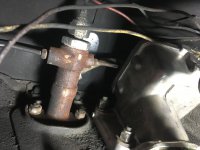Richenrygarcia
New member
- Joined
- Jan 29, 2016
- Messages
- 86
- Points
- 25
Short story long:
I set out to change my rear brake shoes and adjust my parking brake last week. After struggling to remove the drums, I pulled them off, with help from this forum. Now, after changing the rear brake shoes and wheel cylinders, I have an issue that is really frustrating me. I have ZERO pressure in the brake pedal despite multiple attempts to bleed the brakes, using multiple means.
Here's what I've done:
1) I bled the brakes, using a vacuum bleeder, starting at the right/rear tire, then left/rear, then right/front, left/front. Although there was much air in the system, I eventually was able to bleed both rear brakes satisfactorily.
2) I cannot get the front brakes to bleed. I cannot even get fluid to flow from the front brakes using the vacuum bleeder or conventional bleeding (someone pushing the brake pedal). No fluid flow and the brake pedal goes to the floor with no increases in pressure, despite any amount of pushing. I made sure the brake fluid reservoir was kept full throughout the entire process.
3) Here's what I'm thinking: I have upset the master cylinder, as a result of me losing pressure in the system, when opening the hydraulic lines, to change the rear wheel cylinders. This condition is prohibiting me from building pressure within the system, and not allowing me to bleed the brake with a vacuum bleeder or, using conventional bleeding. Is there a way to burp/bleed the master cylinder? I haven't seen in in the manual.
I'm pretty close to calling a tow truck and taking it to a shop, as this issue has me really frustrated. Before I do that, I thought I'd ask the experts on this forum for their opinion.
The car is a 1970 500L, with 126 Personal hubs, brakes. Thank you all, in advance.
I set out to change my rear brake shoes and adjust my parking brake last week. After struggling to remove the drums, I pulled them off, with help from this forum. Now, after changing the rear brake shoes and wheel cylinders, I have an issue that is really frustrating me. I have ZERO pressure in the brake pedal despite multiple attempts to bleed the brakes, using multiple means.
Here's what I've done:
1) I bled the brakes, using a vacuum bleeder, starting at the right/rear tire, then left/rear, then right/front, left/front. Although there was much air in the system, I eventually was able to bleed both rear brakes satisfactorily.
2) I cannot get the front brakes to bleed. I cannot even get fluid to flow from the front brakes using the vacuum bleeder or conventional bleeding (someone pushing the brake pedal). No fluid flow and the brake pedal goes to the floor with no increases in pressure, despite any amount of pushing. I made sure the brake fluid reservoir was kept full throughout the entire process.
3) Here's what I'm thinking: I have upset the master cylinder, as a result of me losing pressure in the system, when opening the hydraulic lines, to change the rear wheel cylinders. This condition is prohibiting me from building pressure within the system, and not allowing me to bleed the brake with a vacuum bleeder or, using conventional bleeding. Is there a way to burp/bleed the master cylinder? I haven't seen in in the manual.
I'm pretty close to calling a tow truck and taking it to a shop, as this issue has me really frustrated. Before I do that, I thought I'd ask the experts on this forum for their opinion.
The car is a 1970 500L, with 126 Personal hubs, brakes. Thank you all, in advance.


